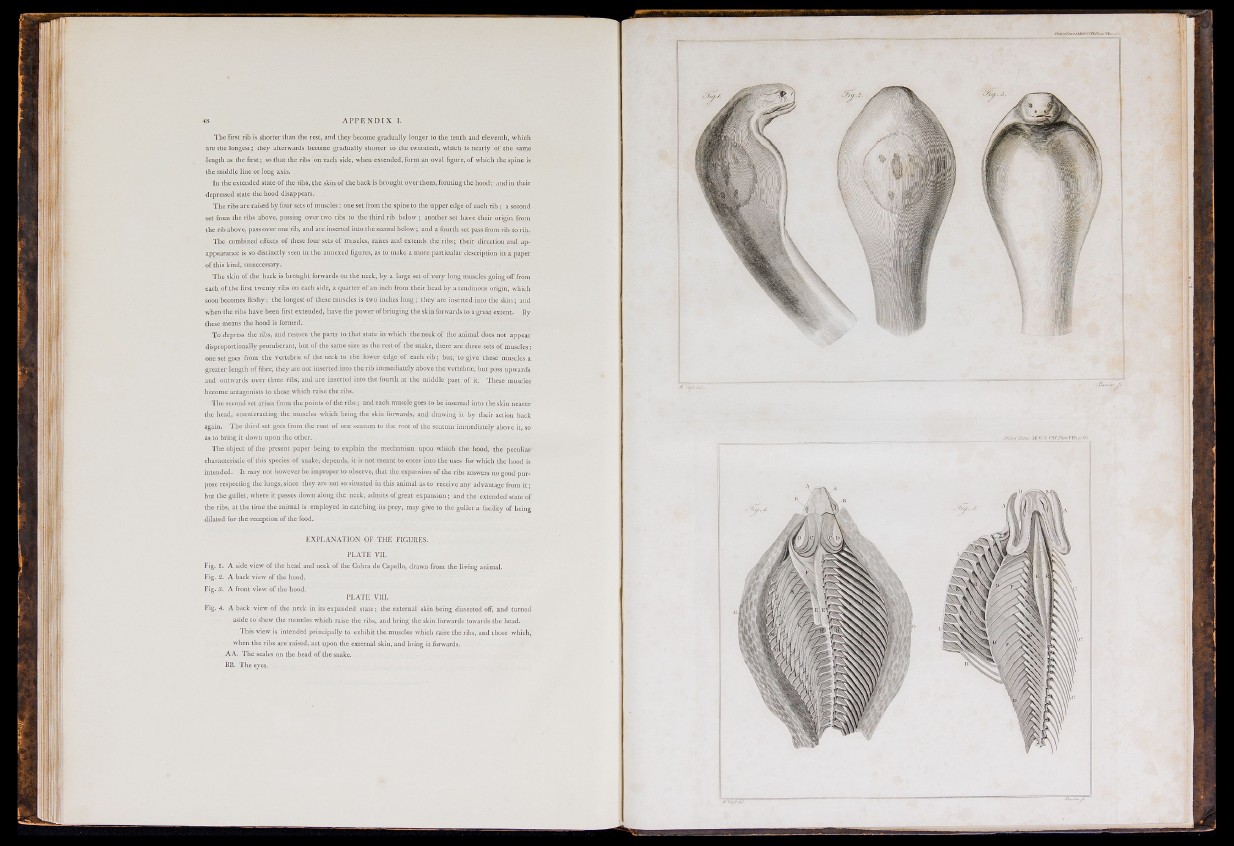
A P P E N D I X I.
The first rib is shorter than the rest, and they become gradually longer to the tenth and eleventh, which
are the longest; they afterwards become gradually shorter to the twentieth, which is nearly of the same
length as the first; so that the ribs on each side, wheu extended, form an oval figure, of which the spine is
the middle line or long axis.
In the extended state of the ribs, tlie skin of the back is brought over them, forming the hood; and in tlieir
depressed stale the hood disappears.
The ribs are raised by four sets of muscles : one set from the spine to the upper edge of each rib ; a second
set from the ribs above, passing over two ribs to the third rib below ; another set have their origin from
the rib above, pass over one rib, and are inserted into the second below; and a four t h set pass from rib to rib.
The combined eflijcts of these four sets of muscles, raises and extends the ribs; their direction and dpappearance
is so distinctly seen in the annexed figures, as to make a more particular description in a paper
of this kind, unnecessary.
The skin of the back is brought forwards on tlie neck, by a large set of ver y long muscles going off h'om
each of the first twenty ribs on each side, a quarter of an inch from their head by a tendinous origin, which
soon becomes fleshy; the longest of these muscles is two inches long ; they are inserted into the skin ; and
when the ribs liave been first extended, have the power of bringing the skin .'brwards to a great extent. By
these means the hood is formed.
To depress the ribs, and restore the parts to that state in which the neck of the animal does not appear
disproportionally protuberant, but of the same size as the rest of the snake, there are three sets of muscles:
one set goes from the vertebra: of the neck to the lower edge of each rib; luit, to give these muscles a
greater length of fibre, they are not inserted into the rib immediately above the vertebne, but pass upwards
and outwards over three ribs, and are inserted into the fourth at the middle part of it. These muscles
become antagonists to those which raise the ribs.
The second set arises from the points of the ribs; and each muscle goes to he inserted into the skin nearer
the head, counteracting the muscles which bring the skin forwards, and drawing it by tlieir action back
again. The third set goes from the root of one scutum to the root of the scutum immediately above it, so
as to bring it down upon the other.
The object of the present paper being to explain the mechanism upon which the hood, the peculiar
characteristic of this species of snake, depends, it is not meant to enter into the uses for which tlie hood is
intended. It may not however be improper to observe, that the expansion of the ribs answers no good purpose
respecting the lungs, since they are not so situated in this animal as to receive any advantage from it;
but the gullet, where it passes down along the neck, admits of great expansion; and the extended state of
the ribs, at the time the animal is employed in catching its prey, may give to the gullet a facility of being
dilated for the reception of the food.
Fig. 1.
EXPLANATION OF THE FIGURES.
PLATE VU.
A side view of the head and neck of the Cobra de Capello, drawn from the living animal.
. A back V
V of the hood.
. A front V
V of the hood.
Fig.
PLATE Vlll.
4. A back view of the neck in its expanded state; the external skin being dissected off, and turned
aside to shew the muscles which raise the ribs, and bring the skin forward,s towards the head.
This view is intended principally to exhibit the muscles which raise the ribs, and those which,
when the ribs are raised, act upon the external skin, and bring it forwards.
AA. The scales on the head of the snake.
EB. The eyes.